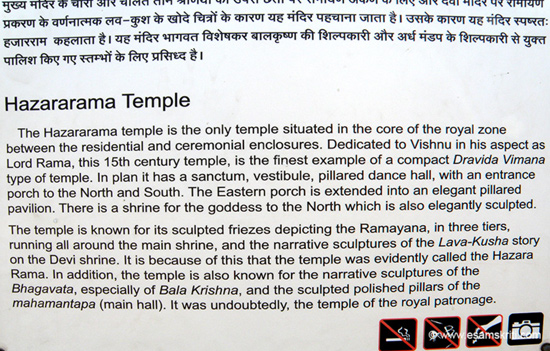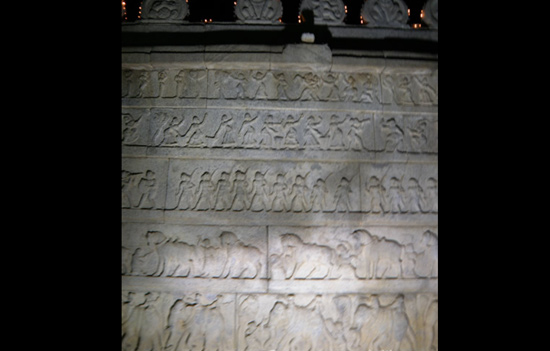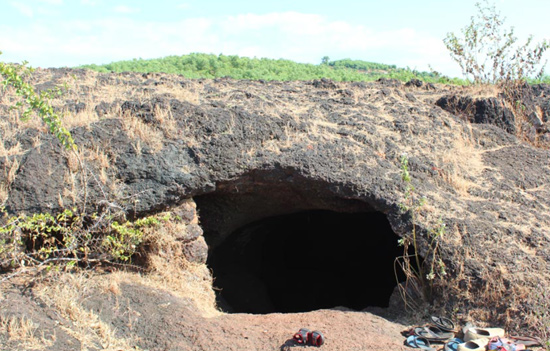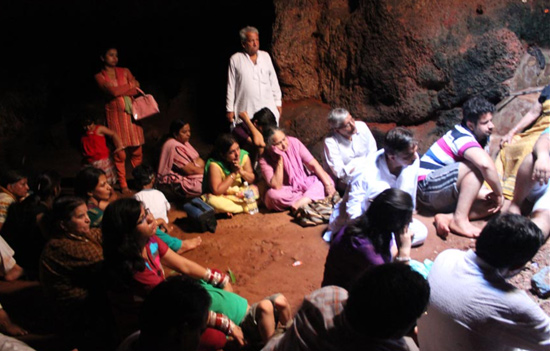- Know about three
revered Rama Temples in Tamil Nadu and age-old references to Sri Ram in Tamil
literature.
As the nation
gears up for the Prana Pratistha of the Rama Mandir
in Ayodhya, there is a section of people who claim that Rama has nothing to do
with the people of the South. Especially in Tamil Nadu there has been a claim
made for the last 100 years that Rama had nothing to do with the Tamil people.
However, what is
the reality? Is Lord Rama truly an outsider or has he lived in the hearts of
the Tamil people since time immemorial?
Tamil Nadu is
known as the land of temples and a cursory look at the temples shows us that
the worship of Rama has been prevalent for centuries.
Though there are
hundreds of Rama temples, both ancient and recently established, we will be
looking at a few unique temples in this article.
1.
Darbha Sayana Ramar, Thirupullani
This temple
which is located in the Ramanathapuram district of Tamil Nadu is unique for the
shrine of Rama in a reclining position.
The village
named Thirupullani, is a combination of two words. Pull (Grass) and Anai
(pillow), derives its name from the unique Dharbhashayana Rama enshrined in the
Adi Jagannatha Perumal temple here. It is said when Lord Rama wanted to cross
the ocean to Lanka, he fasted and did penance here on a bed of Darbha grass,
hence the name Thirupullani.
To
see album of Adi Jagnnatha Temple
Inscriptions in
the temple indicate that it was constructed in the 8th century CE indicating
that the worship of Lord Rama and acceptance of him as a deity was very much in
practice at that time. It is also to be noted that Lord Rama is generally shown
to be standing with a bow and arrow in all parts of India. This murthi of a
reclining Rama is very unique to Tamil Nadu and specifically Thirupullani.
Read
more about this temple and picture of sleeping Rama
2.
Yoga Ramaswamy temple, Nedungunam
This is another
unique temple located in the village of Nedungunam in the Tiruvannamalai
district of Tamil Nadu.
Here Lord Rama
is seated holding the Chin Mudra in his hand. It is said he was seated there at
the request of Maharshi Shuka and is listening to the Brahma Sutras being read
by Hanuman. Here Lord Rama is considered to be a Guru.
The temple is
said to have been constructed by the Pallavas. This once again shows us that
Lord Rama is not considered an outsider but has a very unique and special
relationship in the hearts of Tamil people.
See
temple pictures including that of Yoga Rama with Lakshmana and Sita Devi
and Gopuram panels that has scenes from the Ramayana
3. Erikatha Ramar, Madhuranthakam
The Erikatha
Ramar temple is located in Maduranthakam in the Chengalpet district of Tamil
Nadu (75 kms from Chennai). This temple was built in the Pallava era and is
estimated to be 1600 years old. Lord Rama is the main deity in this temple and
this temple is considered to be one of the oldest Rama temples in South India.
The story behind
the name Eri Katha Ramar is an interesting one.
It is said in
the 18th Century a British officer Colonel Lionel Blaze was the Collector of
the Chengalpet district. He was overseeing the repairs of the huge water
reservoir at Madurantakam and was looking for material to repair the broken
bund. He saw some stone pillars in the Rama temple and said they could be used
for the repairs. The devotees said the stone pillars were kept for the
construction of the shrine of Devi Janakavalli, the consort of Sri Rama. The
collector made fun of the devotees asking why their deity could not protect the
reservoir from overflowing.
In a few days
the rains began and the reservoir filled up to the brim. The collector visited
the areas where the bund was broken and hoped it would not overflow. To his
surprise he saw two men with bows and arrows standing guard there. He realized
that it was Lord Rama and Lakshmana and bowed down to them. The rains stopped
soon and the reservoir was safe. The Collector himself built the shrine for
Janakavalli Thayar and there is a plaque commemorating this till today.
The name Eri
Katha Ramar means the Rama who protected the lake.
For
blog and pictures of this temple
Apart from the
presence of temples dedicated to Lord Rama there are also various mentions in
Tamil literature to Lord Rama. Sangam literature is some of the earliest Tamil
works that are known to us. Some of the earliest
Sangam period poems are found in the Purananooru, an anthology of
various poems describing the life of Tamil people. It is dated between the 1st
and 5th BCE.
In poem number 378, the poet Oonpothi Pasunkudayar praises the Chola King. This verse below, from that poem, draws a parallel between the poet’s relatives and a scene of Sita dropping her jewels and it being picked up by the monkeys.
When my large
family saw that, they took the finger
ornaments and
put them on their ears, put the ear jewels
on their
fingers, those meant for the waist on their
necks, and
those meant for the necks on their waists.
They were like
a huge family of monkeys with gaping red
mouths scooping
up the beautiful ornaments that fell to
the ground,
when the mighty demon snatched away enraged
Raman’s wife Seethai. Purananooru 378
This shows that Lord Rama and his story were known among
the Tamil people.
Another famous literary work from the Sangam period is the
Silappadhikaram. We find references to
Ramayana for e.g. read on.
the very city of Puhar of ancient fame has gone mad — like Ayodhya at the separation of the great hero Rama who left it and penetrated the thick jungles saying, ‘To me the kingdom is nothing, but my father’s command is everything’ - Silappadikaram,
Book 8, Lines 64-68, translated by V.
R. Ramachandra Dikshitar
Another major period for Tamil Literature is the Bhakti
movement during the 7th and 8th centuries. Lord Rama finds mention in many works
of the 12 Alwars or the Tamil Vaishnavite
saints of the period. Find some references below.
1. Nammalvar's Tiruviruttam, verse 36, speaks of the friend of the Alwar who criticises the Lord who once destroyed the crowded halls of Lanka (for the sake of Sita), but fails to relieve the grief of the Alwar.
2. The Periya Tirumoli, written by Thirumangai Alvar (8th
century CE) in verse 8, refers to Guhan, the fisherman king who Rama persuades
not to follow him into exile while crossing the Ganges, and Hanuman.
3. Andal's Tiruppavai, verse 12 makes mention of “the Lord Rama who slew the Lord of Lanka, Ravana” and verse 24 of Tiruppavai reads, “We worship your fame of winning over the king of Southern Lanka.”
4. There are many verses by Kulasekhara Alwar in his
Perumal Thirumozhi which describes the life of Rama as well as paying homage to
the Rama shrine in Chidambaram.
5. In the 12th century CE, the poet Kamban wrote the
Ramavatharam popularly known as Kamba
Ramayanam. It is the story of Rama written in Tamil. Till date, scholars
and the general public, consider it to be one of the best literary works in
Tamil.
6. In the 18th century the entire Ramayana
was written as a Tamil Opera by Arunachala Kavi Rayar. Many of the songs
from this opera are still popular and sung today widely in Tamil Nadu.
In conclusion, if one were to take a brief look at Tamil
architecture, literature and spirituality it would be very evident that Lord
Rama always has been and is a part of Tamil Culture.
To see albums of
over 50 Temples in Tamil Nadu
Album of
Rameshwaram Jyotirling Temple
Editors Notes
To see pictures
of Ramayana at Hazara-Ram Temple, Hampi Karnataka (see pics 37 to 40)

 Ramayana Scenes in temple.
Ramayana Scenes in temple.
Inside
Sugreeva Cave at Hampi are carvings of Rama, Sita and Lakshman (see pics 37 and
38)
At Ram Tirth Hill, Gokarna in Karnataka
 Entrance to cave where Sri Ram lived in exile. A discourse was on when I entered the cave.
Entrance to cave where Sri Ram lived in exile. A discourse was on when I entered the cave.
 Devotees listening to discourse inside cave.
Devotees listening to discourse inside cave.
Also read
1. Why making Ram
Mandir is important for Asia
2. Architecture of
Ram Mandir
3. What is Pran
Pratistha
4. On Chanting the Name of SRI RAM
5. What is the deeper meaning behind the names of Sri Ram and
his brothers
6. Adhyatma Ramayan
marries Bhakti with Advaita Vedanta
7. Many versions of
the Ramayana
8. A sacred journey
to meet Pandit Ramashraya Tripathi Ji, a present-day disciple in the lineage of
Goswami Tulsi Das